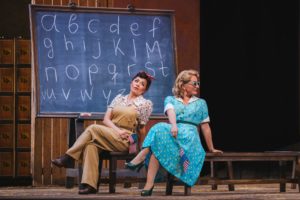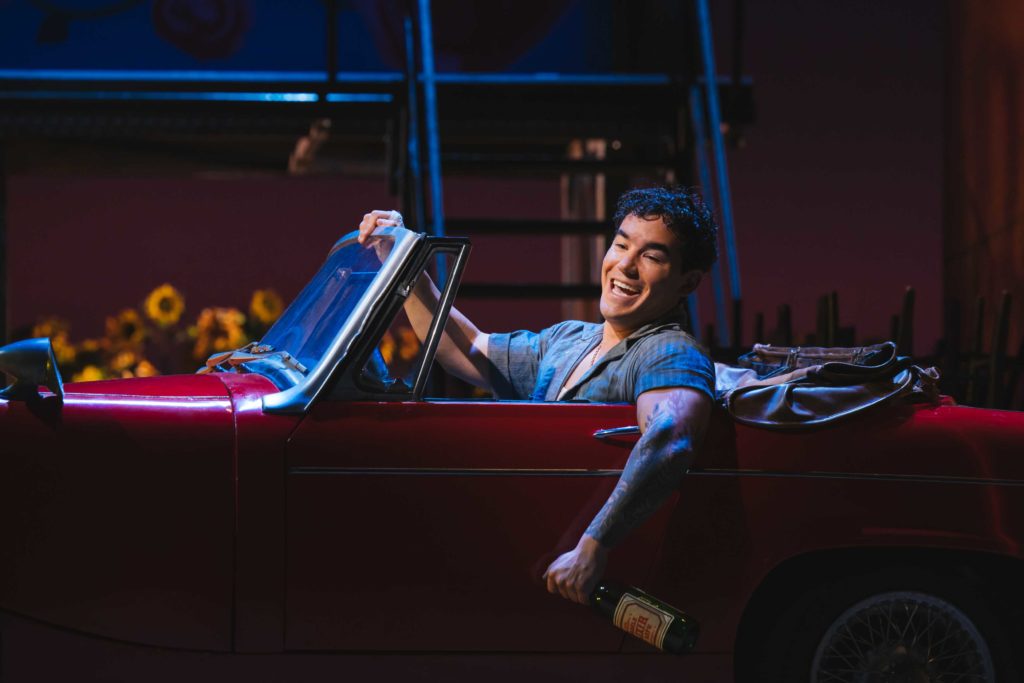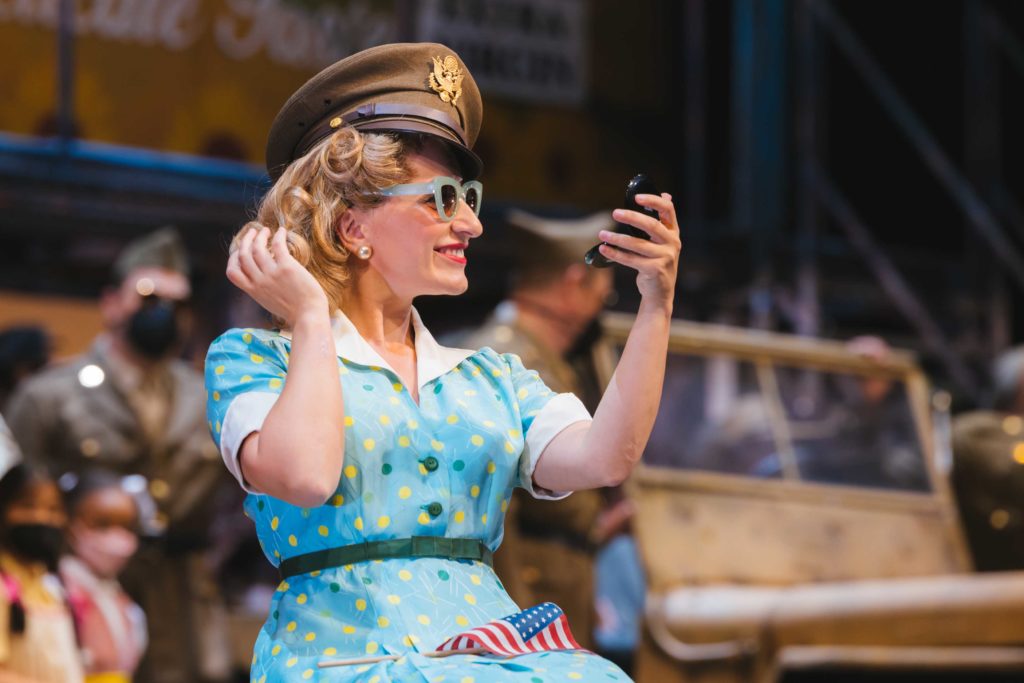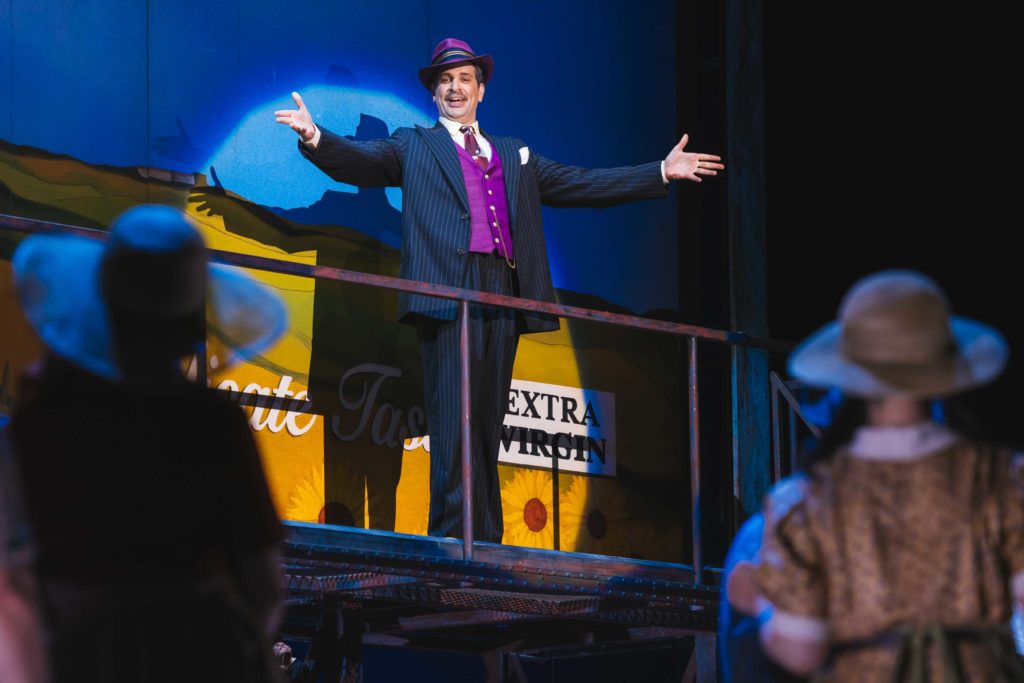
Seattle Opera 2022-23 Review: The Elixir of Love
A Midcentury Update Helps This Summer Production Shine Brightly
By John CarrollSeattle summers are glorious, and Seattle Opera’s sunny production of Donizetti’s “L’elisir d’amore” made this summer even more so. This tuneful comic diversion, originally mounted at the Santa Fe Opera, had just the right amount of sentimentality to put a smile on your face, and Donizetti’s hummable score goes down as easy as a bowl of pistachio gelato.
Leaning into Post-War Nostalgia
The production was set in a sun-soaked Italian village and updated to the optimistic mid-1940s, just after the end of World War II. Carefree American soldiers drive up in their jeep, the priest rides in on a Vespa, and the olive oil factory that seems to be the village’s primary business — advertised prominently on the giant billboard at the back of the stage — keeps everyone busy and the town thriving.
It’s become something of a trend to set classic comic operas in this era (“The Barber of Seville” and “Daughter of the Regiment” have gotten similar treatments, as well as “Carmen” a few seasons back). It’s a formula that works well because it brings the operas into a modern period that is familiar and evokes warm nostalgia, yet distant enough in time from today that the cliched mechanics of the plots and misogyny that underpins the stories almost feels quaint. This production style calls to mind golden age Broadway musicals, in this case, “The Most Happy Fella” meets “Oklahoma.”
A Hopelessly Devoted Mechanic
Andres Acosta was perfection as Nemorino, making his Seattle debut. Handsome with a charming demeanor, he played the role more as a hopeless romantic than a rube. He was sweet-natured and gullible, but not foolish. The concept here was that Nemorino is a car mechanic who runs a small auto repair shop and he is trying to get a compact red sports car to run. Apparently, the car on stage was an Austin-Healy Sprite, a British roadster that wasn’t even produced until 1958, but we will forgive this minor anachronism because it looked marvelous and was used so cleverly throughout the opera.

Andres Acosta as Nemorino in his red sports car (Photo: Sunny Martini)
Acosta’s honey lyric voice was even and graceful across his range, He displayed a beautifully controlled legato and his phrasing was especially sublime during “Una furtiva lagrima,” which was the vocal showstopper one hopes it will be. And this in spite of the fact that the director Stephen Lawless gave him an unwelcome bit of stage business during the aria: lighting and smoking a cigarette! What a silly distraction watching the tenor awkwardly pretending to puff on a fake cigarette between phrases. If it was conceived just so that Nemorino could stomp the cigarette out with his foot at the end of the aria as a metaphor of his resignation, it was a misfire. Kudos to Acosta for staying focused on his emotive singing, not on this directorial nonsense.
Flirting and Dreaming in Style
Salome Jicia was feisty and flirty as Adina, presented as a school teacher in this production. Costume designer Ashley Martin-Davis (who also created the sets) dressed Adina as if for a summer road trip through southern Italy, with colorful light fabrics, wide-brimmed sun hats, and chic sunglasses. Jicia’s Adina was aloof but a bit of a dreamer, too. She never came off as mean-spirited, which made the character’s last-minute revelation of love ring true.

Salome Jicia as Adina (Photo: Sunny Martini)
Vocally, Jicia had the volume and tonal heft that one expects from a full lyric-coloratura — her voice had a presence and was clearly audible at every moment across her entire range. Jicia finessed some fine bel canto moments, especially in her lovely aria “Prendi per me si libera.” Unfortunately, the highest notes that came at the ends of her arias, duets, and ensembles were produced by an unpleasant vocal overdrive which gave her tone an edgy vibrato and wicked stridency.
A Rogue, a Rapscallion, and a Rosie the Riveter
Belcore was portrayed as a Sergeant in the U.S. Army, breezing through this picturesque village in a military jeep with an entourage of soldiers along for the ride. Rodion Pogossov was amusingly narcissistic in the part, which was played remarkably similar to his Escamillo in Seattle back in 2019. He is in his element in these types of roles, though in Donizetti’s music, I found his vocals one-dimensional.

Luca Pisaroni as Dulcamara (Photo: Sunny Martini)
Luca Pisaroni played the quack Dulcamara as a lanky sneak, making his first entrance hiding from the police in disguise as a woman. Even after he reappeared in his dapper purple waistcoat, Pisaroni didn’t fully convey enough comic panache to make the role soar. He played Dulcamara as a sly villain who is bemused to stumble by sheer luck into such an easy con, but he came off a bit stiff, physically and vocally. I missed that certain sense of Willy Wonka twinkling his eye and voice, even if he is a charlatan.
Tess Altiveros made the most that she could of Giannetta, who frustratingly has very little to do. Dressed as a working gal a la Rosie the Riveter, she was mostly a collection of silent-yet-knowing reactions to Adina’s shenanigans until her moment in the spotlight in Act Two, which Altiveros delivered with fun, bawdy stage business.
Yes, Conducting Can Be a Form of Cheerleading
In his first appearance with Seattle Opera, conductor Giampaolo Bisanti shaped the music with flair. Beyond leading the crisp, smooth-toned orchestra flawlessly, he emanated an aura of positive energy from the pit that lifted the spirits of everyone in the venue.
Categories
Stage Reviews


